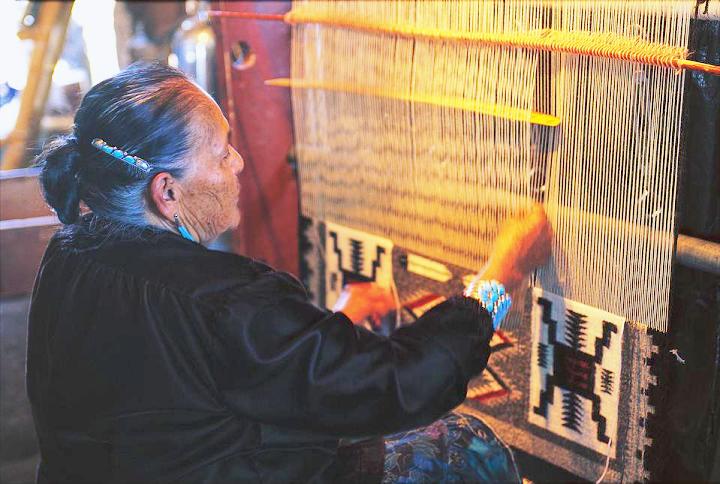 |
Canku Ota
|
 |
|
(Many Paths)
|
||
|
An Online Newsletter
Celebrating Native America
|
||
|
February 2021 - Volume
19 Number 2
|
||
|
|
||
|
How The Navajo Nation
Is Transforming Math Education
|
||
|
by Julia Brodsky - Contributor,
Forbes Magazine
|
||
From intricate numerical systems to astronomical observatories, from suspension bridges to geometrical ornaments and board games, Native American civilizations have been innovators in the fields of mathematics and engineering. While European invasion dealt considerable destruction and persecution to Native American cultures, members of Indigenous groups have demonstrated unwavering interest and talent when it comes to mathematics. During World War II, for example, Navajo Code Talkers were revered for their bravery as well as their cryptography skills. “Mathematics is in our blood,” says Henry Fowler of Navajo Bitter-water and Zuni Edgewater clans, who is an associate professor of mathematics at Navajo Technical University. “Our Navajo women are the knowledge keepers, and they instill the love for mathematics into children at an early age.” Fowler was gently introduced to mathematics by his mother, Sally Fowler, in her own traditional way. As a preschooler, he acquired the concepts of symmetry, geometric shapes, rotations, dilations, and transformations by observing her weaving Navajo rugs. He watched how she estimated the length of yarn that she would need for weaving a rug of a certain area, and learned ratios and proportions while crafting baskets and carving wood. As he got older and helped herd sheep, he learned to estimate distances and calculate the speed of cattle to make sure they could quickly get to safety in the event of a sudden monsoon. The only Navajo-speaking student at his boarding school, Fowler often found refuge in mathematics. His teachers noted that he would approach the problems differently from other students. When he was a student at Northern Arizona University, his mathematics professor observed that his unique and intuitive way of thinking about problems could serve his nation well if he became a math teacher. Many years and a doctorate degree later, he is one of the most highly esteemed math educators in the Navajo Nation and a creator of a Navajo-centered math curriculum. His goal is to help Navajo people to apply their talent to modern mathematics, engineering and science while giving a boost to Navajo Nation economics and prosperity. He envisions math education to be engaging, fun, full of exploration, relevant to students’ backgrounds and immersed in their native culture. One program that embodies his goals is the Navajo Nation Math Circles project, a joyful and inspirational way to introduce students and the general public to the beauty of mathematics through extracurricular activities. This project was the dream of Tatiana Shubin, a Soviet-American mathematician raised in Kazakhstan. In January 2011, after meeting with co-founder and co-director David Auckly, the dream was made a reality: together they reached out to the Navajo community, investors, and finally, to Fowler, who was an ideal community leader to represent the project.
Project activities were launched in the Fall of 2012. A team of distinguished mathematicians from all over the US, as well as local teachers and community members, work together to run the outreach. Navajo Nation Math Circles present math in the context of Navajo culture, helping students develop their identity as true Navajo mathematicians. “We want to find kids who would not have discovered their talents without our project, to help them realize that they can change the world,” says Fowler. Having introduced Navajo children to the joy of mathematics, the project also yielded a book, Inspiring Mathematics: Lessons from the Navajo Nation Math Circles, which contain lesson plans, puzzles and activities, and other insights for parents and teachers to embrace. An extension of Navajo Nation Math Circles is an annual two-week Baa Hózhó summer math camp at Navajo Technical University. “Baa Hózhó” means “balance and harmony,” tying together the ideas of mathematical equilibrium with the way of life embraced by Navajo people. The summer camp is widely popular with parents and children; the older students come back as counselors, making everyone feel like one big family. It is preceded by an annual student-run math festival in local schools across the Navajo Nation, where students share their passion for mathematics with families and friends. Fowler’s ultimate goal is to create a Mathematical Research institute on Navajo land, where local and international researchers could exchange math ideas and study the best ways of teaching mathematics to Indigenous people, enriching worldwide mathematical sciences. Hopefully, the great strides in the Navajo Nation math education will encourage leading high-tech companies to support the rise of a new generation of diverse, talented and passionate Native American STEM professionals. To learn more about the Navajo Nation Math Circles project visit
Julia Brodsky |
||
|
|
|
|
||
|
|
||
| Canku Ota is a free Newsletter celebrating Native America, its traditions and accomplishments . We do not provide subscriber or visitor names to anyone. Some articles presented in Canku Ota may contain copyright material. We have received appropriate permissions for republishing any articles. Material appearing here is distributed without profit or monetary gain to those who have expressed an interest. This is in accordance with Title 17 U.S.C. Section 107. | ||
|
Canku Ota is a copyright ©
2000 - 2021 of Vicki Williams Barry and Paul Barry.
|
||
 |
 |
|
|
The "Canku
Ota - A Newsletter Celebrating Native America" web site and
its design is the
|
||
|
Copyright ©
1999 - 2021 of Paul C. Barry.
|
||
|
All Rights Reserved.
|
||
